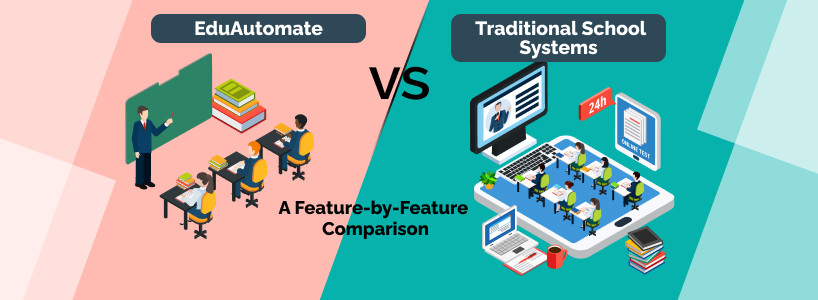In todays fast-evolving education landscape, technology is redefining how students learn and how teachers teach. One of the most revolutionary platforms leading this change is EduAutomate (ERP Software) a modern, AI-powered learning management system that brings automation and personalization into the classroom. But how does it really compare to the traditional school system that has shaped education for decades? Lets explore a feature-by-feature comparison to understand the real difference.
1. Learning Flexibility
Traditional schools follow a fixed schedule and uniform teaching style, leaving little room for personalized learning. EduAutomate, on the other hand, offers flexibility through digital classrooms that adapt to each learners pace. Students can revisit lessons, access study materials anytime, and even take assessments when they feel ready something thats nearly impossible in a conventional setup.
2. Teacher Efficiency
In traditional schools, teachers spend hours on administrative tasks like attendance, grading, and lesson planning. EduAutomate automates these repetitive processes, allowing educators to focus more on teaching and mentoring students. Its smart analytics also help teachers track student progress instantly and provide targeted support where needed.
3. Student Engagement
One of the biggest challenges in the old-school model is maintaining student engagement. EduAutomate solves this through interactive content, gamified assessments, and real-time feedback. The result is a more immersive learning experience that keeps students motivated and encourages active participation.
4. Data-Driven Insights
Traditional systems often lack tools to measure performance trends or learning outcomes effectively. EduAutomates AI-based reporting dashboard provides data-driven insights that help teachers and school administrators make informed decisions. This modern approach ensures continuous improvement in both teaching methods and student results.
5. Accessibility and Inclusivity
While traditional education can be limited by geography or infrastructure, EduAutomate promotes inclusivity by making education accessible from anywhere. Students from remote areas or those with physical challenges can learn conveniently using digital devices, ensuring that no learner is left behind.
6. Cost and Sustainability
EduAutomate reduces the need for printed materials, physical classrooms, and manual record-keeping. This not only makes it more cost-effective but also supports eco-friendly, paperless learning a crucial step toward sustainable education.
Final Thoughts
While traditional schools have built the foundation of learning, EduAutomate represents the future a future that blends innovation, accessibility, and personalization. The combination of technology and education through platforms like EduAutomate Learning System empowers both students and teachers to achieve more in less time.
For educators and institutions looking to modernize their teaching approach, exploring AI-powered education solutions like EduAutomate can be the key to delivering smarter, more impactful learning experiences in 2025 and beyond.
